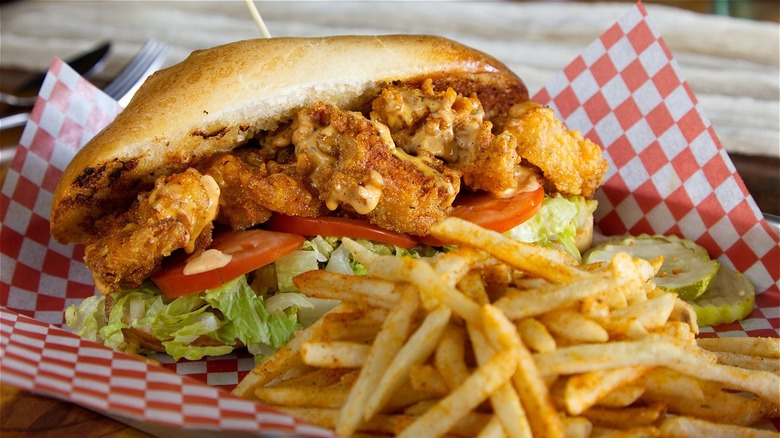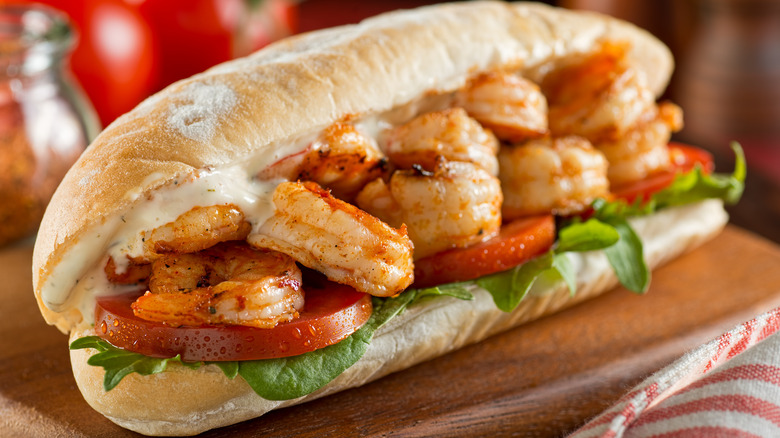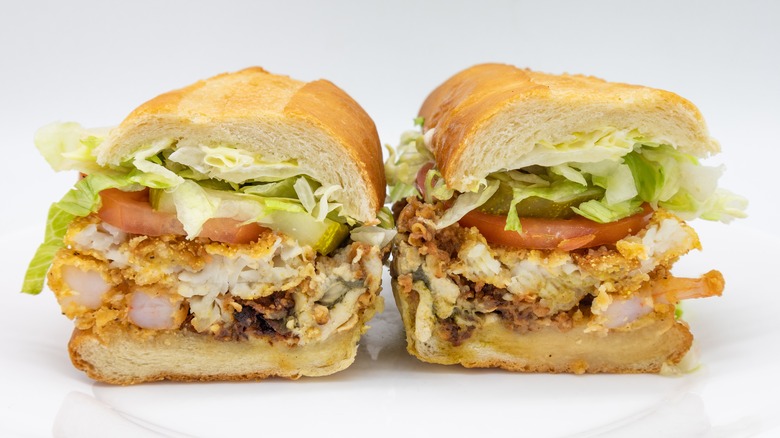The Absolute Best New Orleans Po'Boys According To Locals
Po'Boys and New Orleans go hand in hand. Like everything in the Crescent City, it is unique to the culture of Louisiana. After all, up until the Louisiana Purchase of 1803 when the United States purchased the territory, most households spoke French even after the purchase (via Slate). Americans settled in the Garden District to the west of the central area known as the French Quarter. However, even as English started to become more common, the marks of the previous culture permeated in the architecture, the culture, the names of the people, and most of all the types of food that make the Southern city extremely unique in the US.
When you hear the words Gumbo or Jambalaya, you think of New Orleans. When you hear red beans and rice or beignets, you think of New Orleans. All these foods have a history, an origin story about how they came into existence. While all these nationalities, and of course the Native Americans, had their own foods and recipes, sometimes the food that was available or the cooking methods were different. As such, what happened was they slowly evolved to become the dishes they are today. The Po'Boy — the New Orleans sub sandwich — has its own story and locals love to tell you about it, what makes a great po'boy, and of course, their favorite places to buy them.
Oh! Po'Boy! What's in a name?
If you're thinking the sandwich name kind of sounds like "poor boy," you'd be right. It got its slang name from what everyone originally referred to it as. However, the history of where the sandwich originated and how it got its name is a little muddy. Many New Orleans tour guides will tell you the story of how it was invented by the Martin Brothers who owned a coffee stand in the now-famous French Market. They claimed that during a transit strike in 1929, they would feed the workers for free with a long French loaf that was filled with meat and could be cut into several smaller pieces.
According to New Orleans Historical, when Bennie Martin would see one of the striking men coming for a sandwich, he would say, "'Here comes another poor boy.'" Thus, the sandwich was referred to as the "po'boy." Other sources, however, indicate that the style of sandwich existed in the area before this time. There's also evidence of other sandwich shops claiming they were the original creators. While this might have been the case, the Martin Brothers are the ones who most likely put it on the map with their advertisements and write-ups in the local papers, per NOLA.com.
Today, there a numerous eateries serving po'boys. It's a staple that many local Louisianians grew up with and love. So for an authentic experience when visiting the unique city on the banks of the Mississippi, it's always best to ask their advice.
New Orleanians share their favorites
When asked what makes a good po'boy sandwich, most locals will immediately answer, "the bread." New Orleanians on the Facebook group Where NOLA eats agreed. Rene Bonee said, "You always want your po-boy bread to be fresh and crispy. Without good bread, it really doesn't matter what else is right or wrong, as nothing is worse than soggy bread." Mirriah Beck also said, "The bread is number one for me." The bread is made in the French loaf style with a crispy crust and soft insides.
After that, people in the group suggested that a sandwich that was over-stuffed with meats or fried seafood and then dressed with mayonnaise or other sauces was important.
Over 100 locals weighed in with their opinions about where to get the best po'boys. While the list of places mentioned were wide and varied, several received more Facebook likes than others. Popular eateries included Crabby Jack's in Old Jefferson and Bear's in Covington. Red Wagon Grocery in Harahan and Pontchartrain Po Boys on the North Shore and Parkway also received some love. For tourists, some of these eateries may be a bit out of the way from the French Quarter hotels. The only exception to this is that locals also voted for NOLA Po'Boys which is located on one of the main tourist thoroughfares at 908 Bourbon Street. One local recommended the "spicy fried shrimp smothered in crawfish and shrimp bisque."


